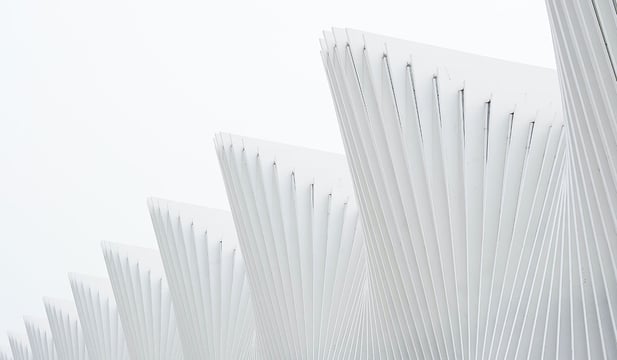The ABCs of Visual Merchandising in 2023: From Planograms to Point of Sale

The ABCs of Visual Merchandising in 2023: From Planograms to Point of Sale
Visual Merchandising is as much of an art as it is a science in finding the most captivating and efficient ways to create a great customer experience - and drive in-store sales. Just like any field that requires some scientific thinking, it contains a great deal of specific terminology used in store merchandising directives and general retail discussions. With that being said, here's 13 key terms - along with explanations - every Visual Merchandiser and retail professional should be aware of:
1. Fixture (or back-wall etc)
A fixture is a location in a store - for example a back wall or gondola. To merchandise a back-wall refers to how the space will be filled with products, props, branding and signage. The merchandising of a fixture is done via a planogram - and software exists out there (just like Display) to help store teams merchandise their back according to clear, visual instructions.
2. Planogram
A planogram details how the merchandising and layout of a store is planned out. The planogram forms as a schematic or diagram for merchandising teams to follow and is generally included as part of a wider brief - or Visual Merchandising directive.
3. PoS
PoS, lengthened to Point of Sale, refers to a checkout area where customers make purchases. This is generally the end of a customer's in-store journey. A great deal of emphasis is placed by Visual Merchandisers here on making 'up-sells' - utilizing techniques to help encourage an impulse buy.
4. Up-Sell
An up-sell refers to a product purchased at the end of a customer journey - usually at the Point of Sale. Many Visual Merchandisers make use of effective signage and consumer psychology techniques to assist in driving more up-sells.
5. SIGNAGE
Taking the form of graphics, icons, photos and text, signage is the visual communicator in a store. Signage covers directions to Point of Sale areas, changing rooms, special offers and are carefully crafted around directing the customer journey to achieve maximum efficiency - as well as return on investment.
6. Focal Point
A focal point is a hotspot that acts as the centrepiece of a merchandising design in combination with styled mannequins or displays, props or signage. These focal points tend to be placed in key sightlines, for example entrances to store departments and are mostly evident in window displays.
7. Sightline
A sightline refers to an unobstructed view a customer's eyes has between their position and the positioning of a display. Placing displays in key sightlines - for instance after walking inside a department store - is crucial in Visual Merchandising in order to draw shoppers to follow certain pathways and to maximize sales turnover of a store.
8. Product Story
A product story is a merchandising technique that aims to place a product within a certain context or theme. The idea behind a product story gives a customer more reason to imagine themselves purchasing and wearing (or using) a product. Generally props and all sorts of signage and mannequins are used to create a product story.
9. Mannequin
Mannequins are intended to show off a product in a more kinetic, human context. They can range from being simple, upright store mannequins to custom-built ones designed around a specific purpose - for example a sports retailer may utilize mannequins that look as if they are poised to run, whereas a high-end fashion boutique may instead make use of mannequins in elegant poses to dress their clothes in.
10. Visual Merchandising Directive
A Visual Merchandising - or VM - directive is a brief that covers how a whole store, or new collection, is merchandised. Each retailer has their own preferred method of delivering a VM directive to their stores. When it comes to larger retailers who have multiple stores of different sizes, it's important to ensure that the directive is relevant to the actual store - ensuring it has the correct fixtures and products available.
11. Cluster
A store cluster refers to a group of stores that have been 'clustered' into types based on defining characteristics - for most retailers, this tends to be by size. Stores can also be clustered based on performance but when it comes to Visual Merchandising, grouping them based on size and availability of fixtures is most common (known as 'store grades')
12. Prop
Props fall under any non-saleable objects in store that are used to convey a certain theme, style or ambience. They are used to heighten the aesthetic of a store and are commonly placed in Visual Merchandising displays - like storefront windows and store back-walls. Consider things like photo frames, artwork, and almost any object put to good creative use.
13. Ambience
Ambience revolves around creating an atmosphere in your store that is most likely to drive sales. Like any atmosphere, it's highly dependent on a customer's senses - so there's lots of ways store ambience can be manipulated and managed. Touch, sight, smell, and hearing all play a huge part in how a customer perceives their shopping experience and in-store music has long been studied as an important psychological factor in making buying decisions.
Visual Merchandisers and retail planners all over the world use Merchandising software.
From creating planograms in 2D and 3D and sending VM directives to store communication and compliance, MockShop and IWD Platform cover the whole merchandising process.
Want to see our software in action for yourself? Get in touch with us for a demo!
MORE ARTICLES BY THIS AUTHOR

Maxine




.png?width=330&name=BLOG%20COVER%20(1200%20x%20630%20px).png)